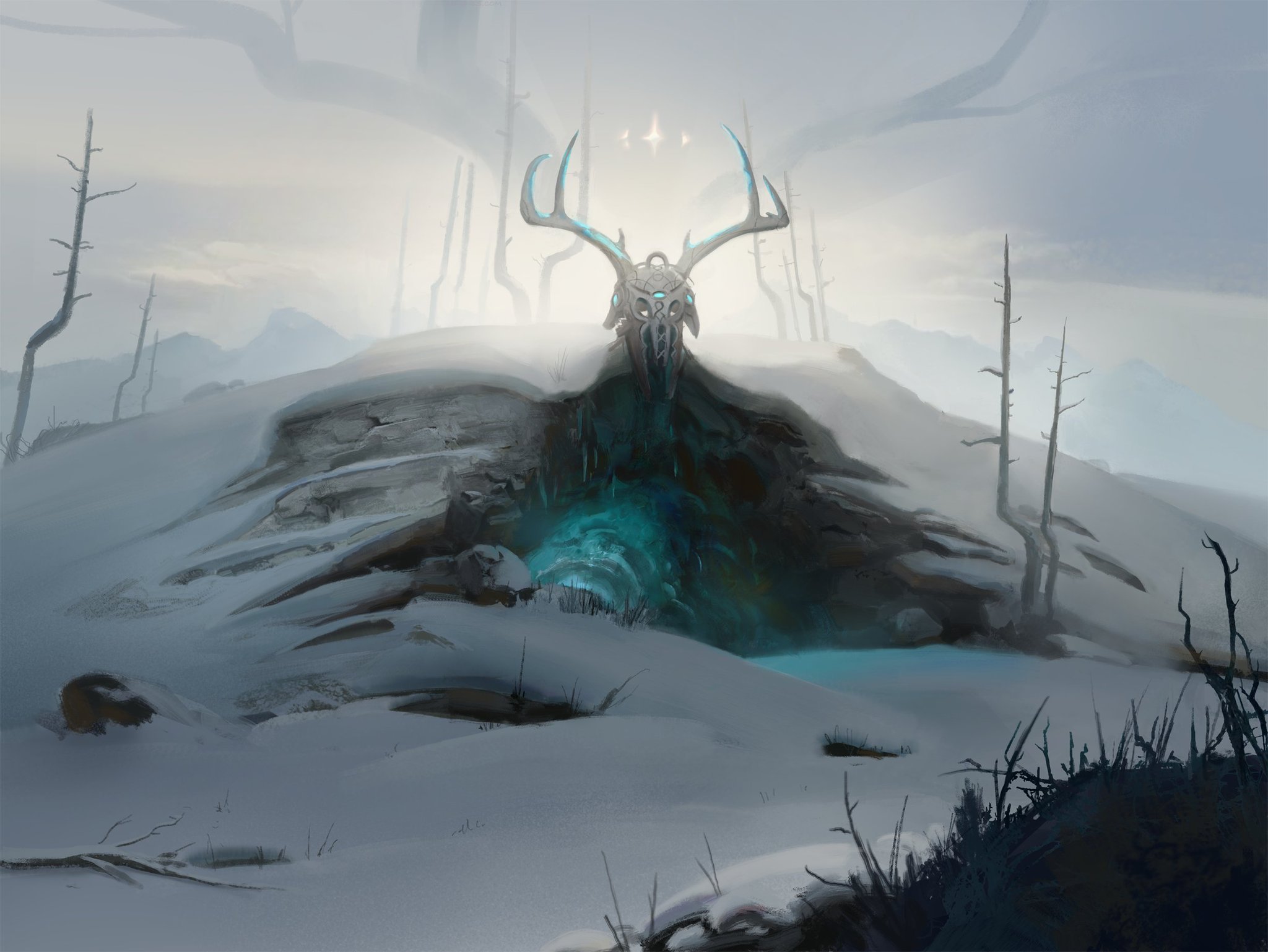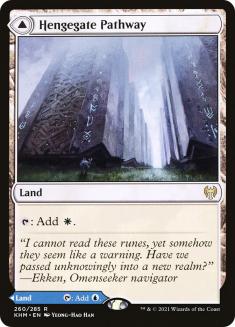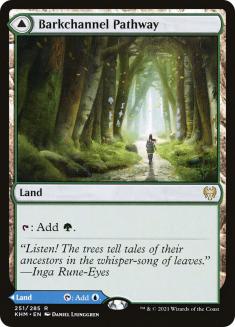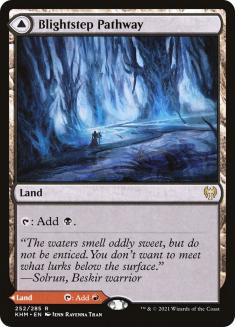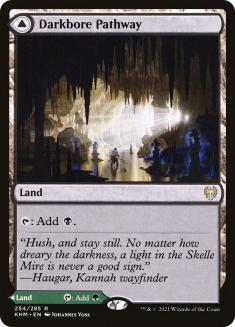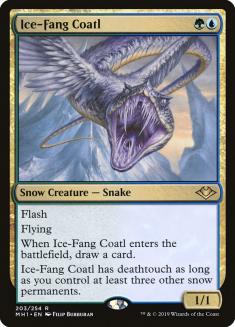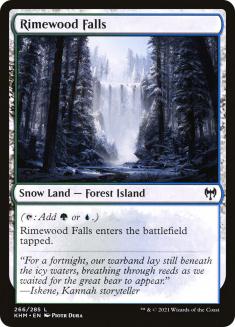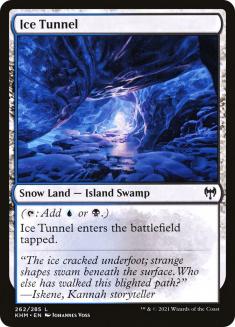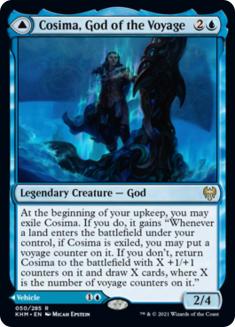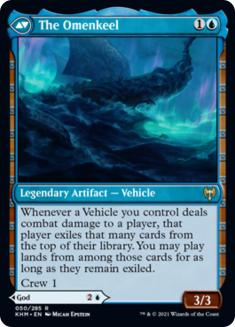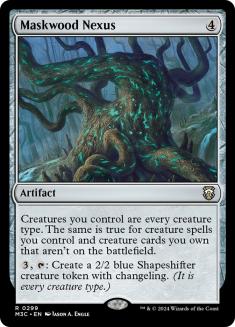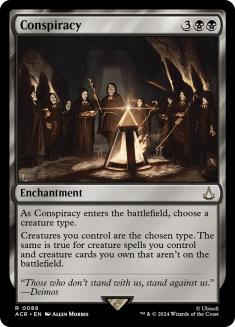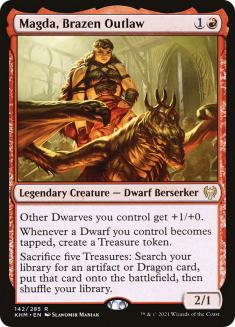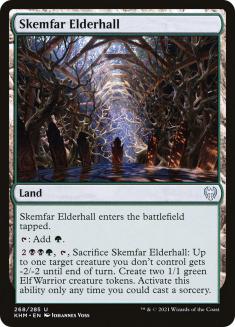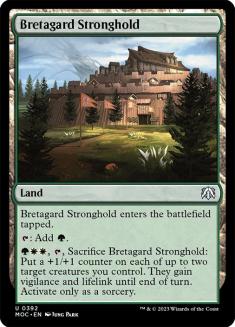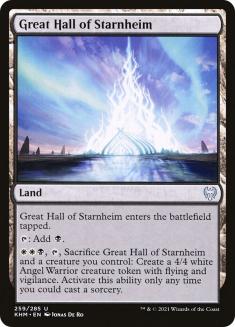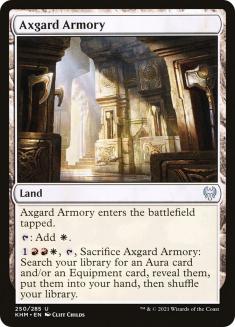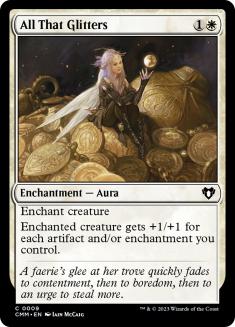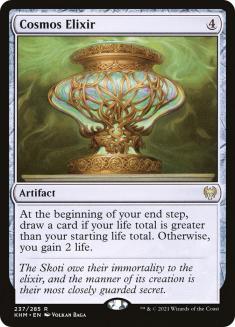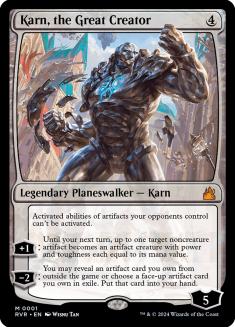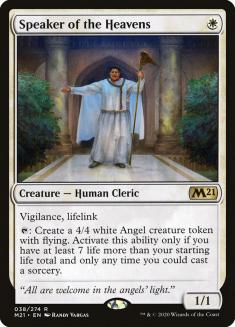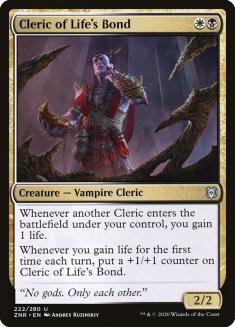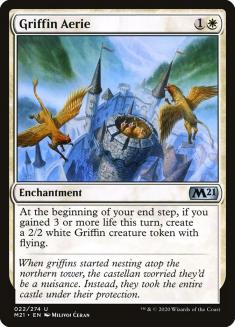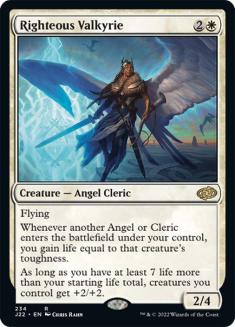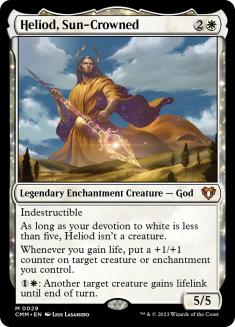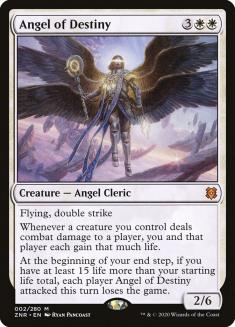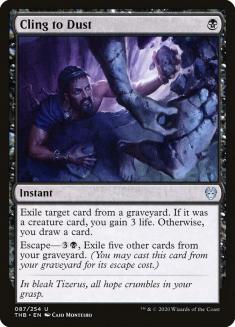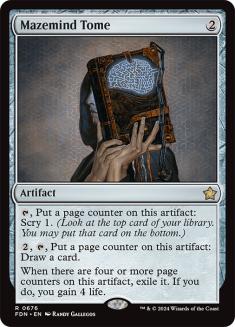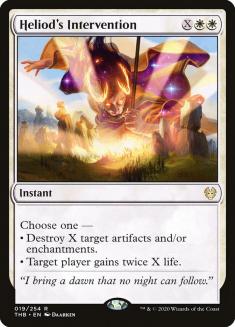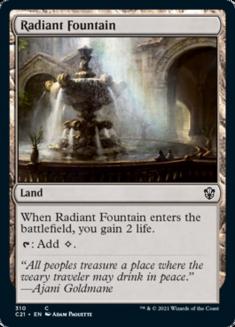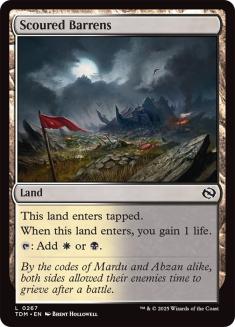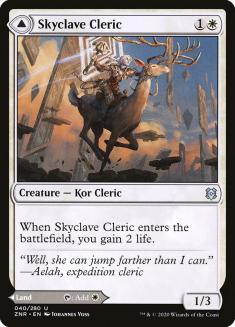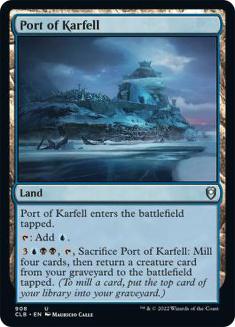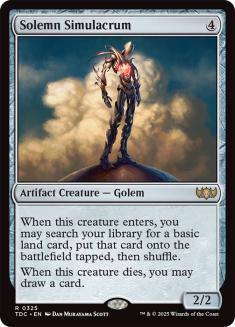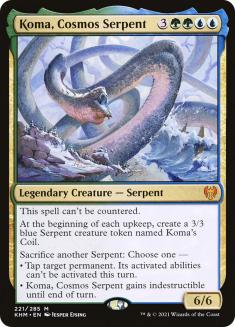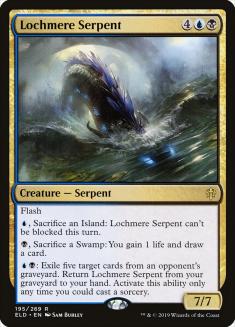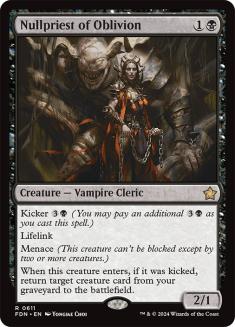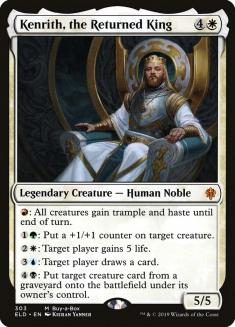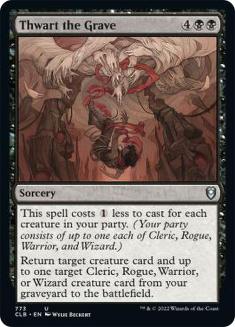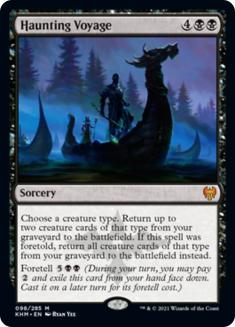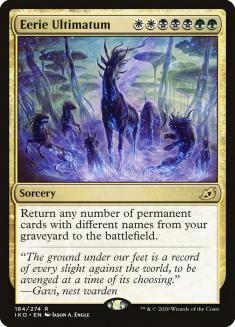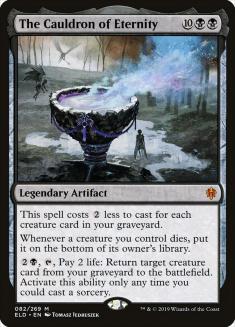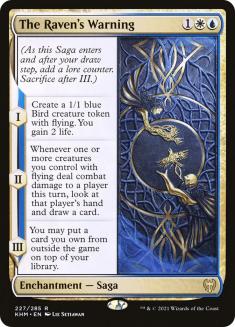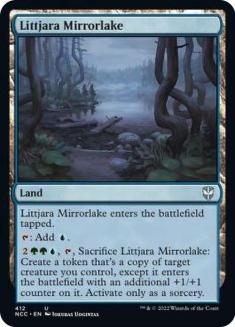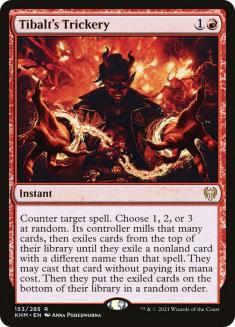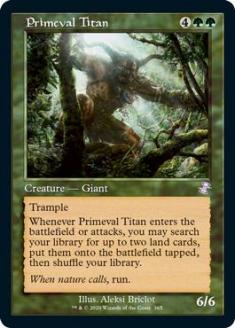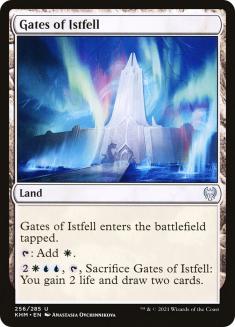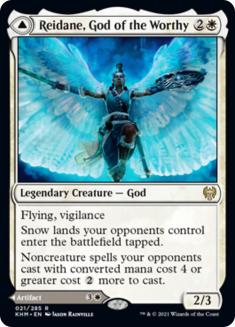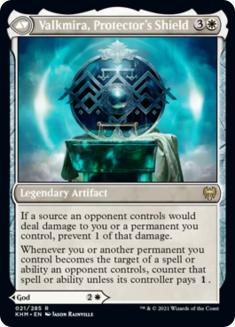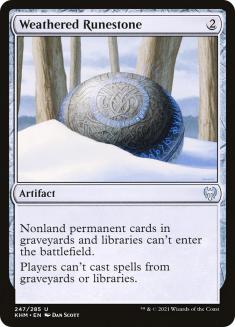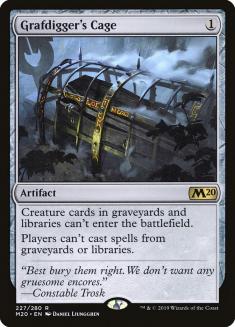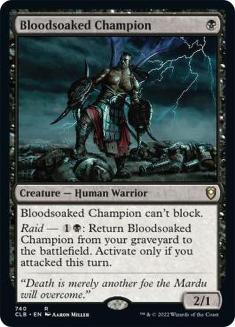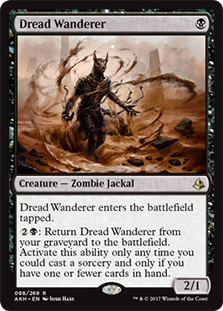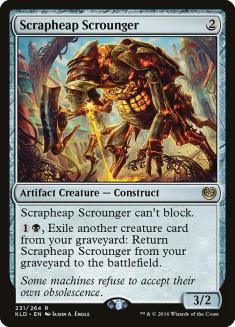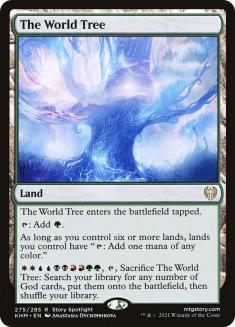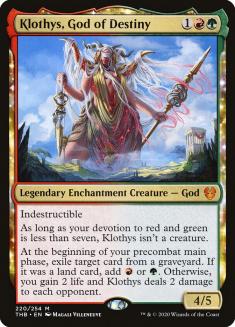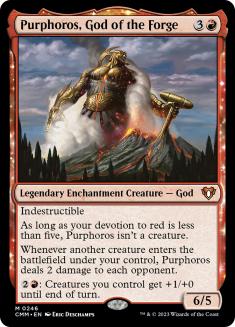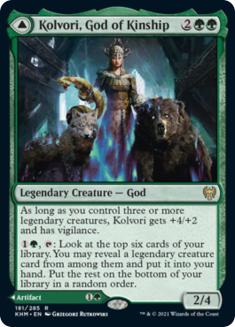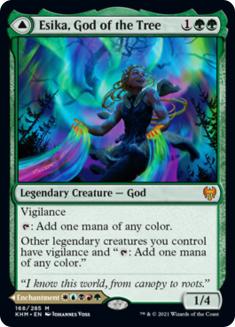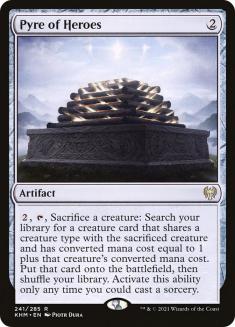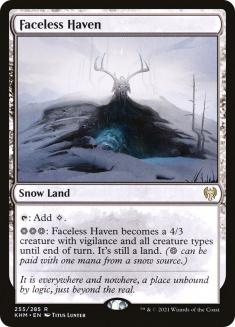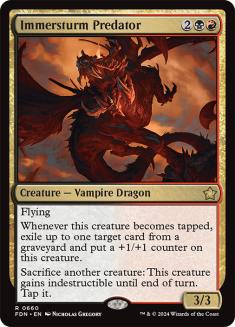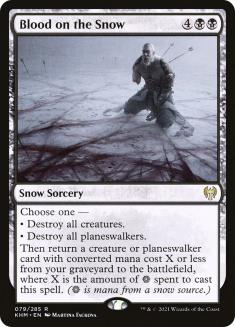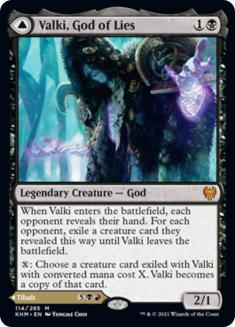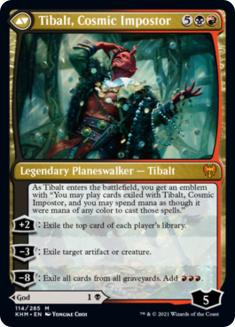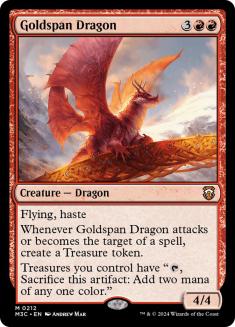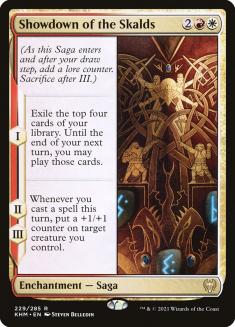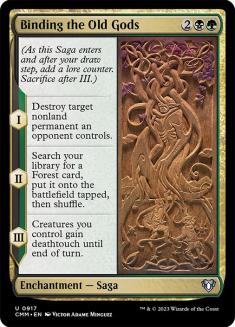Look, I gotta level with you. The top 10 list would be a lot less interesting if we just give all the slots to the mana-fixing. They’re all dynamite and you just kind of put ‘em in decks that want these colors of mana.
Even the snow-covered dual lands are all impactful, both for Standard and in Modern, where the ability to fetch up a snow-covered dual is a big deal in a world with cards like Ice-Fang Coatl.
For instance, here’s an example of Rimewood Falls and Ice Tunnel doing a lot of work for making up for the Arcum’s Astrolabe we can no longer play:
Creatures (14)
Lands (25)
Spells (21)

Love to see Cosima, God of the Voyage out there just banging, by the way. Ice-Fang Coatl and Snapcaster Mage make very respectable crews for The Omenkeel.
There’s just so many excellent lands in this set, not to mention a few nice artifacts, they already do a lot of crowding out of the exotic buildarounds. For instance, we only barely have room for Maskwood Nexus (largely on account of how sweet it is), but it’s also a little bit of a longshot.
But before we get there, be sure to check out my top 10 white cards, top 10 blue cards, top 10 black cards, top 10 red cards, top 10 green cards, and top 10 multicolor cards if you missed them.
10. Maskwood Nexus
You can play it as a token-maker that feeds into every tribal synergy, but the real fun comes from the Conspiracy-esque combo potential.
However, you can actually go even further with Maskwood Nexus, since you’re not just making your creatures all the type of your choice; you’re actually getting to make them all every type. This can enable some unusual combos that wouldn’t otherwise be possible.
With a Maskwood Nexus, your Magda, Brazen Outlaw triggers off every one of your creatures (since they’re all Dwarves), while at the same time having the ability to find any creature in your deck (since they’re all Dragons).
The uncommon cycle of lands that can be sacrificed for two colors of mana to get a spell-like effect are also pretty solid across the board, and that’s ten cards right there. Some of them are pretty straightforward like Skemfar Elderhall and Bretagard Stronghold.
If you’re playing a Golgari Elves deck or a Selesyna +1/+1 counters deck, they’re fine options in moderation.
Great Hall of Starnheim is just not as strong as it may appear, but if you’ve got an Orzhov or Mardu Sacrifice deck, it might be worth it in small numbers. Some of them, however, are a little spicier to try to build with, like Axgard Armory.
9. Axgard Armory
Axgard Armory is a little bit of an odd one to look at, but the rate is there, so honestly, I kind of believe. Four mana (kind of a virtual five, since you’re also sacrificing the land) and a card (the land itself) to draw two is already at least in the conversation; but that you get selection? There’s a ton of potential here. As long as your deck has Auras and Equipment that are consistently worth more than random cards, you’re kind of doing it.
Like, sure, you could really go hard, maybe build around All That Glitters, or whatever, but you don’t need to.
I’m not saying it couldn’t work. It definitely could. It’s just not a for-sure thing at all, given how “exotic” of an archetype we’re talking about here. Even just as a rough starting point, it doesn’t look bad. This could definitely be tunable.
Creatures (18)
- 4 Bonecrusher Giant
- 4 Acclaimed Contender
- 2 Archon of Sun's Grace
- 3 Alseid of Life's Bounty
- 1 Halvar, God of Battle
- 4 Runeforge Champion
Lands (23)
Spells (19)

I gave the nod to Bound in Gold over Nahiri’s Binding on account of the ease of casting, since the ability to suppress Vehicle activation is only slightly weaker than the ability to suppress mana creatures. What’s more, Bound in Gold can actually target artifacts and lands, which is just a huge step up in versatility.
We don’t need to go so hard, however. Like, what if you’re playing something along the lines of RYUGI’s Boros Aggro list?
Creatures (28)
- 4 Robber of the Rich
- 3 Bonecrusher Giant
- 4 Seasoned Hallowblade
- 4 Selfless Savior
- 1 Skyclave Apparition
- 4 Luminarch Aspirant
- 1 Halvar, God of Battle
- 2 Goldspan Dragon
- 1 Clarion Spirit
- 4 Usher of the Fallen
Lands (22)
Spells (10)

You’ve already got Maul of the Skyclaves and Embercleave, which should be plenty for our purposes. They’re both real strong and cast a pretty wide net for situations they’re good in.
We will need some Auras, but not necessarily many. For instance, what if we literally just had one each of Spectral Steel, Pacifism, and Bound in Gold to support two copies of Axgard Armory? And obviously, if Bound in Gold just proves enough better than Pacifism, we could just play more of it. It’s not like we actually need a toolbox out of our Auras. Bound in Gold is pretty darn flexible as it is.
8. Cosmos Elixir
RYUGI’s list does bring up an excellent point. Cosmos Elixir is at this interesting crossroads between sideboard card and build-around. Is it for control decks that want extra life gain against aggro and card draw against control and ramp? Is it a buildaround enabler and eventual reward for lifegain decks? Is it for aggressive midrange decks that want a stopgap against decks on the extremes?
I’m super into this sort of design, where it’s so open-ended with so much potential in so many directions, but with a subtle push towards midrange for decks using it and a little extra strong against decks built too extreme (fast or slow).
That it is an artifact can also be quite valuable. Already the card is becoming a common option for Karn, the Great Creator sideboards in Pioneer, for instance.
It’s a very mana efficient way to stay ahead of burn, and the ability to get and play it against control or combo decks, letting us out-grind whatever creature and planeswalker removal they may be trying to attrition us with.
Creatures (19)
Planeswalkers (12)
Lands (21)
Spells (8)
Sideboard
- 1 Tormod's Crypt
- 1 Darksteel Citadel
- 1 Grafdigger's Cage
- 1 Orbs of Warding
- 1 Ulamog, the Ceaseless Hunger
- 1 Aligned Hedron Network
- 1 Skysovereign, Consul Flagship
- 1 Heart of Kiran
- 1 Sorcerous Spyglass
- 1 Damping Sphere
- 1 Meteor Golem
- 1 God-Pharaoh's Statue
- 1 Golos, Tireless Pilgrim
- 1 Stonecoil Serpent
- 1 Cosmos Elixir

The prospect of going all-in on some kind of a lifegain build around doesn’t actually look too shabby, either, though. There’s actually a ton of incentives:
There’s also an awful lot of ways to gain life on generally good cards.
We even get to play eight lands that help the cause (or potentially even more, depending on how into Skyclave Clerics we are).
Here’s a starting point that I’m pretty excited to try out. It’s probably going to have some giant vulnerabilities at first, but this sort of a deck is very tunable.
Creatures (18)
- 1 Heliod, Sun-Crowned
- 4 Speaker of the Heavens
- 4 Cleric of Life's Bond
- 3 Angel of Destiny
- 2 Skyclave Cleric
- 4 Righteous Valkyrie
Lands (23)
Spells (19)

Having so many ways to leverage our life advantage for more material or battlefield presence might call into question some of our assumptions about what kinds of support cards we need. For instance, maybe we’re supposed to play a little more cheap spot removal to one-for-one on account of how much card advantage we can get from our artifacts and enchantments?
7. Port of Karfell
Getting a (basically) uncounterable reanimation effect from one of our lands is a really big opportunity; so even though it does cost a virtual seven, I’m optimistic about Port of Karfell’s chances. We’re not always even getting ahead on mana, but the opportunity cost is low and the selection high (and that’s to say nothing of activating the Port on your opponent’s endstep).
That it gives us four shots in the dark is nice, definitely; but as long as we’ve got some backup targets like Solemn Simulacrum and Yorion, Sky Nomad, we shouldn’t have to rely on rolling the dice too often.
We don’t even necessarily need to try very hard, or anything. What’s stopping us from putting two or three Ports in some kind of fairly standard Dimir-based Yorion deck?
Creatures (12)
- 3 Solemn Simulacrum
- 1 Lochmere Serpent
- 2 Atris, Oracle of Half-Truths
- 3 Yorion, Sky Nomad
- 3 Koma, Cosmos Serpent
Planeswalkers (1)
Lands (37)
Spells (30)
- 2 Negate
- 2 Disdainful Stroke
- 4 Omen of the Sea
- 3 Elspeth's Nightmare
- 4 Shark Typhoon
- 4 Heartless Act
- 4 Mazemind Tome
- 1 Soul Shatter
- 4 Binding the Old Gods
- 2 Saw It Coming
Sideboard

Having more looks for Koma is awesome, and the interaction with Lochmere Serpent is great whether it’s what you get back or not.
I’m not saying Yorion’s getting banned or anything, but a whole lot of possibilities open up if that ever happens. Besides, in any case, there’s a lot to experiment with for a more dedicated reanimation strategy.
Mythos of Brokkos is perfect for getting Koma into our graveyard, while also getting us card advantage and selection. Polukranos, Unchained is a nice one-of for Mythos of Brokkos decks, anyway, and makes a totally passable target for the Port. Waker of Waves is an especially enticing threat lets us use it as cheap selection and draw smoothing when we actually draw it, while also stocking our graveyard with relatively decent hits.
There’s also a pretty interesting and diverse mix of unusual reanimation options we might be able to weave together.
And reanimation doesn’t have to be the only way we capitalize on having a stocked graveyard and expensive spells. Titans’ Nest is even a graveyard-stocking enabler, along the lines of Egon, God of Death’s Throne. I’m not sure there’s enough here to compete with Yorion, but then again, maybe we can just embrace Yorion and try a build with The Raven’s Warning.
The Raven’s Warning third chapter can ensure our Port of Karfell can reanimate whatever we want…
6. Littjara Mirrorlake
The most reliable option for Littjara Mirrorlake is just a minor roleplayer in a ramp deck, letting us get a little extra business out of our resources. A little more exciting, however, is the potential for using Littjara Mirrorlake in abusive combo decks with an inordinate affinity for land.
If you’re playing some kind of fairly deterministic Tibalt’s Trickery deck (maybe aspiring to Trickery your Zirda or Kaheera), you could easily have 35 or more land. If you’re Trickery’ing Koma, Cosmos Serpent onto the battlefield Turn 5, it’s kind of sweet to be able to copy it next turn, you know?
If we’re talking about the kinds of formats Primeval Titan hangs out in, that’s kind of interesting, right? The Titan can potentially search your one-of copy up and then copying a Primeval Titan is obviously a really big game.
5. Gates of Istfell
This one’s about as straightforward as they come. I don’t love the rate, but it is lined up well for what some Azorius Control decks are looking for. I definitely wouldn’t play too many, but I don’t hate it as a one-of in super normal straightforward lists:
Planeswalkers (5)
Lands (25)
Spells (30)

By the way, Reidane, God of the Worthy is definitely a sideboard card intended to be played as Valkmira, Protector’s Shield.
As a lock piece, it’s actually pretty reasonably well suited to fighting burn, tokens, and combo. Generally speaking though, it’s just a solid roleplayer for a very defensive deck.
4. Weathered Runestone
Weathered Runestone is the latest in a long line of cheap artifact hate cards that aspire to hit a reasonable range of narrow strategies to help justify the sideboard space in medium-powered formats and up. This one is actually a fairly straightforward riff on Grafdigger’s Cage.
It costs one more; but its first ability stops all nonland permanents, rather than just creatures (note that like Grafdigger’s Cage, this doesn’t stop cascade). Here’s an example of the sort of list that might use Weathered Runestone as a sideboard option for some metagames:
Creatures (25)
- 3 Bloodsoaked Champion
- 4 Scrapheap Scrounger
- 4 Dread Wanderer
- 2 Spawn of Mayhem
- 4 Knight of the Ebon Legion
- 4 Rankle, Master of Pranks
- 4 Murderous Rider
Lands (24)
Spells (11)

You do have to be careful, since it turns off your self-reanimating creatures, but the theory is that in the right matchups, it’s so high-impact it doesn’t matter (and they usually aren’t killing your creatures anyway).
Of course, you can also just use it as a tool against stuff like Kroxa, I just worry about reliance on permanents that yield no immediate advantage, nor attack proactively. Cards like Binding the Old Gods really punish this sort of stuff, and that’s kind of a big part of Standard, at the very least, at the moment.
3. The World Tree
The World Tree is a super appealing land with two distinct abilities that you don’t even necessarily need to care much about both to potentially still be interested in.
The mana-fixing ability kind of gives you a free Prismatic Omen, albeit without the land type synergies. It’s not until Turn 6, of course; but having all your mana problems go away can be sweet if you’re playing some kind of weird three or four-color Yorion or ramp deck. It’s also not actually that unreliable of a way to play a lot of Ultimatums, if you build your deck to it.
While you kind of want to get at least a little out of the second ability, it’s not clear how much you even need from it to be worth it. For instance, RAV104’s Omnath deck only plays two distinct Gods:
Creatures (23)
- 4 Purphoros, God of the Forge
- 2 Elvish Rejuvenator
- 4 Arboreal Grazer
- 2 Golos, Tireless Pilgrim
- 3 Klothys, God of Destiny
- 4 Uro, Titan of Nature's Wrath
- 4 Omnath, Locus of Creation
Planeswalkers (4)
Lands (39)
- 1 Snow-Covered Plains
- 1 Snow-Covered Mountain
- 2 Snow-Covered Island
- 3 Snow-Covered Forest
- 1 Temple Garden
- 3 Breeding Pool
- 1 Hallowed Fountain
- 2 Glacial Fortress
- 1 Sunpetal Grove
- 2 Evolving Wilds
- 3 Hinterland Harbor
- 1 Radiant Fountain
- 1 Blast Zone
- 1 Castle Vantress
- 4 Fabled Passage
- 4 Ketria Triome
- 4 Raugrin Triome
- 4 The World Tree
Spells (14)

It’s not that Klothys, God of Destiny and Purphoros, God of the Forge aren’t powerful permanents or anything. They definitely are.
It’s just that they’re not necessarily always auto-wins, yet, they can still be worth it, on account of the relatively low opportunity cost.
Purphoros is a particularly important God to The World Tree too, since giving all your other Gods haste can actually just win the game on the spot, if you put in the deckbuilding effort. I’m not sure you have to go all the way to playing Kolvori, God of Kinship, but when paired with Esika, God of the Tree, we can really just play whatever legends we want.
Esika, God of the Tree is also just one of the biggest sleepers in the set (if people would just stop Binding the Old Gods’ing it for one minute…).
This list might be too crazy, but there’s nothing wrong with daring to dream big!
Creatures (20)
- 1 Klothys, God of Destiny
- 1 Purphoros, Bronze-Blooded
- 1 Niambi, Esteemed Speaker
- 1 Realmwalker
- 3 Valki, God of Lies
- 1 Alrund, God of the Cosmos
- 3 Kolvori, God of Kinship
- 4 Esika, God of the Tree
- 1 Egon, God of Death
- 3 Cosima, God of the Voyage
- 1 Reidane, God of the Worthy
Planeswalkers (1)
Lands (26)
Spells (13)

You don’t actually need to be playing Gods for Tyrite Sanctum to have purpose (and it might not do enough here); but it does look like it could be a passable roleplayer in some kind of aggressive deck with a sufficient number of legends.
As far as tribal cards go, one of the most appealing, out the box, is Pyre of Heroes, with instant applications for at least Goblins, and probably several other tribals (particularly with Changelings).
2. Pyre of Heroes
The new Birthing Pod, an extensive card breakdown courtesy of Ari Lax can be found here. Basically, you mostly have to be focused on a tribe, but there is some funky stuff you can do if you’re feeling frisky.
Already, Pyre of Heroes has lived up to the hype, appearing as a major component of some new versions of Modern Goblins decks. For example:
Finally, to top it all off, we have the new Mutavault…
1. Faceless Haven
Like Mutavault, Faceless Haven has a very wide array of potential uses and homes. It’s kind of just a real low opportunity cost efficient threat (assuming you can support plenty of snow mana, so technically, the opportunity cost varies).
Izzet Midrange❄, Mono-Red Aggro❄, Mono-White Aggro❄, Boros Aggro❄, Gruul Aggro❄, Mono-Blue Snow❄, dedicated Snow decks (particularly Blood on the Snow) — there’s a lot of immediate homes. Here’s a little more eclectic of a strategy that very much appreciates having a creature-land it can use to get more mileage out of its sweepers.
Creatures (10)
Planeswalkers (3)
Lands (19)
Spells (28)

Ok, time to get down to business. My top 10 cards of Kaldheim are…
10. Immersturm Predator
9. Faceless Haven
8. Blood on the Snow
7. Cosima, God of the Voyage // The Omenkeel
6. Koma, Cosmos Serpent
5. Valki, God of Lies // Tibalt, Cosmic Impostor
4. Tibalt’s Trickery
3. Goldspan Dragon
2. Showdown of the Skalds
1. Binding the Old Gods

